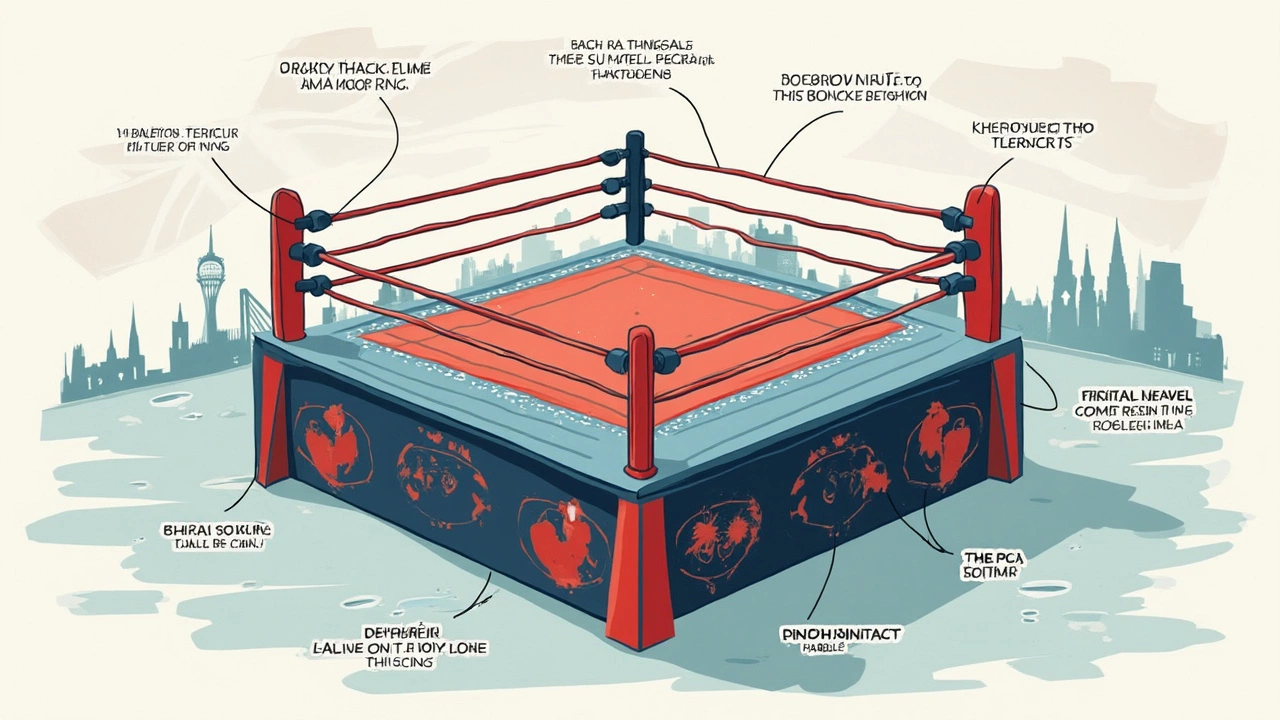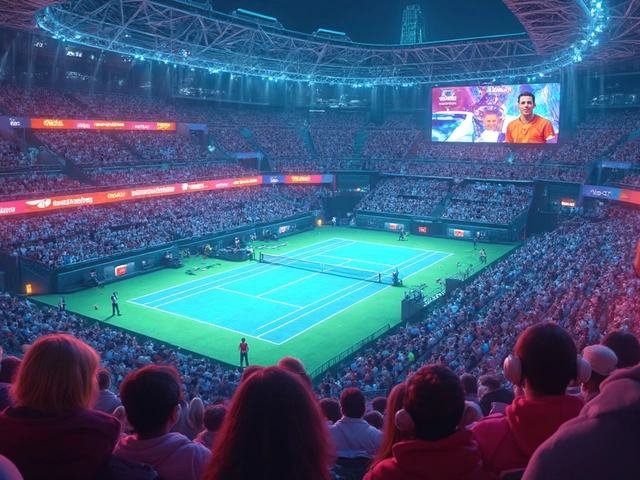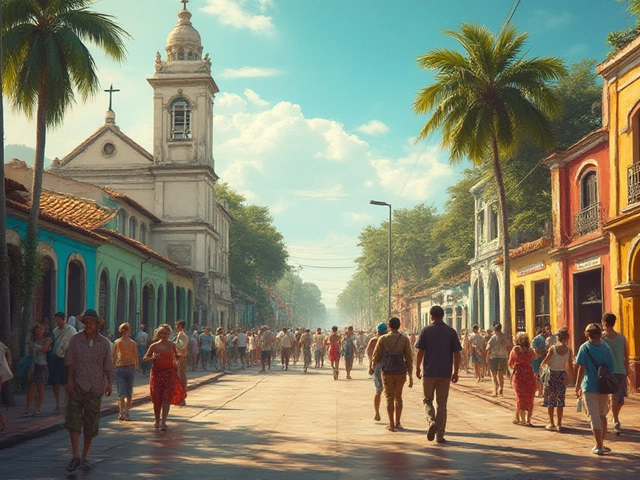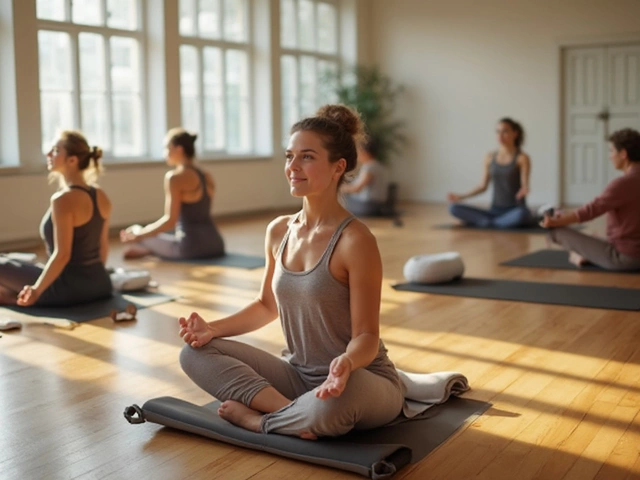
Boxing Matches June 15, 2025
Boxing Ring: Where Every Match Really Happens
So you want to know what the place where boxing is played is actually called? Here’s the plain answer: it’s called a boxing ring. But here’s the weird part—despite the name, it’s not round at all. The classic boxing ring is a square platform with ropes around it. Go figure, right?
If you’ve only seen boxing in movies or on TV, you’ve definitely spotted that elevated space, bright lights, fighters bouncing around, and a ref in the middle. That’s the nerve center of any boxing match, whether it’s a huge championship fight in Vegas or just a friendly spar at your local gym. The ring isn’t just a pretty platform; it’s built to absorb shock, with padding to soften falls and ropes to keep boxers from tumbling out. A good ring makes the fight safer and more exciting—think about it like a big safety net and stage rolled into one.
Next time someone asks where fights happen, you’ll sound like a total pro if you mention the ring size too—most pro rings measure between 16 and 24 feet on each side. This changes things up: some boxers love bigger rings for more movement, while others want a smaller ring to stay in close and brawl. It's not just about the fighters, but the actual space they fight in!
- What Is the Boxing Ring Called?
- Why Is It a Square If It’s Called a Ring?
- Quick Tour: Inside a Boxing Ring
- Famous Boxing Venues Around the World
- What Makes a Great Boxing Venue?
- Tips for Your First Boxing Match Experience
What Is the Boxing Ring Called?
If you ask anyone who’s spent a minute in the sport, they’ll tell you—the action goes down in the boxing ring. That’s the official name, and it’s used across pro fights, Olympic bouts, amateur gyms, and just about everywhere someone throws a punch. Don’t call it an arena or a stage; it’s always “the ring.” Even when folks say fighters are “stepping into the ring,” they mean the actual, physical ring you see in every match.
This term’s been around for centuries. Way back in early bare-knuckle days, fighters would stand in a literal ring drawn on the ground. Modern rings, though, are built for real use. According to the Association of Boxing Commissions,
“The ring remains the universally recognized location for official contests, designed to balance safety, visibility, and fairness for all competitors.”
Rings are pretty standardized these days, especially in pro leagues. Here’s a look at the typical specs you’ll find in major matches:
| Feature | Pro Standard |
|---|---|
| Shape | Square |
| Size (Side Length) | 16–24 feet |
| Rope Layers | 4 |
| Padding Thickness | 1–2 inches |
| Platform Height | 3–4 feet off ground |
No matter the size or setup, the ring stays the same at its core—a place with clear boundaries where all the rules apply, and where all the drama unfolds. Fans, refs, and judges watch every move from outside, but only the fighters and a referee enter.
One quick tip: If you’re talking to someone in the know, never call it a boxing mat or court. That’ll mark you as an outsider right away!
Why Is It a Square If It’s Called a Ring?
This is one of those questions that stumps a lot of people, even boxing fans. You look at a boxing ring and, sure enough, it’s a square. So why stick with the name "ring"? Turns out, this goes way back to when boxing wasn't as neat or official as it is now.
Before boxing became an organized sport, folks used to hold fights anywhere they could—fields, barns, you name it. The crowd would form a circle, or a ring, around the fighters. No ropes, no platform, just people standing shoulder-to-shoulder. That’s how the whole concept got started: fighters in the middle, people forming a ring around the action.
By the 1800s, official rules came along (the London Prize Ring Rules in 1743, then the Marquess of Queensberry Rules in 1867), and organizers began building actual platforms for matches. It’s easier to put four posts in the ground and run ropes between them, so the "ring" became a square for practical reasons. But everyone was already used to calling it a ring, so the name stuck, even as the shape changed.
- The classic boxing ring today is mostly a square, usually anywhere from 16 to 24 feet on each side.
- Each "side" is lined with ropes—typically four—which keeps the fighters safe and helps referees control the action.
So that’s the weird truth: what started in an open field with a big crowd circle became the modern boxing ring you see today, still called a "ring" out of respect for tradition—even if it’s sharp at the corners and not round at all.
Quick Tour: Inside a Boxing Ring
If you’ve never stood in a boxing ring, it’s easy to miss just how simple and purpose-built it really is. At first glance, it’s just a raised square platform with ropes. Look a bit closer, though, and you’ll spot a bunch of small details made for safety and action.
Start with the boxing ring floor. It’s usually 3 to 4 feet above the ground and always padded—this isn’t just some wooden deck. The padding is usually 1 to 2 inches thick, topped with canvas for grip. That makes every move, slip, or fall a whole lot safer than just fighting on a gym floor.
The ropes are another big deal. Standard rings have four ropes—think of the corners as checkpoints, helping keep fighters contained and breaking up the space so there’s no real place to hide. These ropes are pulled super tight and wrapped in soft material to prevent injuries if a boxer’s backed up or knocked down. Each corner has padded posts, and you’ll see two corners colored red and blue for fighters, with the other two neutral (often white) for officials and medics.
Let’s break down the key stuff you’ll spot inside any pro ring:
- Size: Usually between 16 to 24 feet on each side (measured inside the ropes), but most big matches go for 20 feet.
- Height: 3–4 feet above the ground, with sturdy wooden or metal framing.
- Ring ropes: Four ropes, thick and coated for safety, roughly 18 inches apart vertically.
- Padded canvas: Canvas mats add grip; padding gives shock absorption for those heavy falls.
- Corner pads: Four corners, each with heavy-duty padding—red and blue for fighters, neutral for officials.
Here’s a quick look at standard pro ring features in a table:
| Feature | Details |
|---|---|
| Ring Size | 16–24 feet (most common: 20 feet) |
| Height | 3–4 feet off ground |
| Ropes | Four, spaced 18 inches apart |
| Canvas Padding | 1–2 inches thick |
| Corner Pads | Red, Blue, and two Neutral (white) |
Besides the physical setup, you’ll also notice little touches like buckets, towels, and water bottles hanging out in each corner. These aren’t just for show; after a tough round, trainers rush in to patch up their fighter, cool them off, and offer quick advice. The neutral corners are go-to spots for referees and medics when checking on fighters between rounds.
Bottom line: The ring’s design is all about safety, movement, and giving the fighters a fair shot—no matter their style or size.

Famous Boxing Venues Around the World
When people think boxing, most picture the glitzy lights of Las Vegas or the roaring crowd at Madison Square Garden. These venues aren’t just random places with a ring—they’re loaded with history and have seen some of the biggest battles in the sport.
Probably the most legendary spot is Madison Square Garden in New York City. Fighters say there’s nothing like it—the energy, the noise, the atmosphere. It’s where Muhammad Ali fought Joe Frazier in the "Fight of the Century" in 1971. If you ever see a calendar packed with title bouts, MSG is always on the list.
Over in Las Vegas, the MGM Grand is known for those flashy, pay-per-view fights. Think Floyd Mayweather, Manny Pacquiao, Tyson Fury—the list of big names is endless. The MGM is almost as famous as the stars who’ve fought inside its ring.
Across the pond, London’s O2 Arena and Wembley Stadium are where you’ll catch the biggest UK fights—Anthony Joshua has packed over 90,000 fans into Wembley, which is wild for any sport.
Don’t forget about some classic outdoor venues, too. The Caesars Palace parking lot in Vegas might sound odd, but it hosted some epic fights under the stars back in the '80s. Huge crowds, crazy scenes, and a piece of boxing history for sure.
“Crowds at the Garden are different, and every fighter knows there’s a special kind of pressure and honor stepping into that ring.” — Max Kellerman, boxing analyst
Check out these quick facts about famous venues:
| Venue | Location | Famous Fight | Capacity |
|---|---|---|---|
| Madison Square Garden | New York, USA | Ali vs Frazier (1971) | Around 20,000 |
| MGM Grand Garden Arena | Las Vegas, USA | Mayweather vs Pacquiao (2015) | About 17,000 |
| Wembley Stadium | London, UK | Joshua vs Klitschko (2017) | 90,000+ |
| Caesars Palace (Outdoor) | Las Vegas, USA | Leonard vs Hearns (1981) | 15,000+ |
| Tokyo Dome | Tokyo, Japan | Buster Douglas vs Tyson (1990) | Over 50,000 |
These places aren’t just buildings—they’re a big part of what makes the sport so exciting. If you ever get the chance to visit one, even when there’s no fight going on, it’s worth it for the vibe alone.
What Makes a Great Boxing Venue?
A top-notch spot for boxing isn’t just about a big crowd or flashy lights. The right venue keeps everybody safe, amps up the energy, and gives fans and fighters a night to remember. Let’s break down what sets the best places apart from the rest.
- Boxing ring quality: You want a sturdy, well-padded ring with solid ropes and good bounce. If the ring’s too hard or the ropes are flimsy, it’s bad news for fighters.
- Seating layout and visibility: There’s nothing worse than missing the action behind someone’s head. Venues with tiered seats or clever layouts make sure every fan can see the punches land.
- Safety features: This means medical staff on standby, clear walkways, and emergency exits that aren’t blocked. After some tragic accidents in past decades, official rules made these a must.
- Location and access: Easy parking or public transport options are a big deal. Ever tried to leave Madison Square Garden after a main event? The chaos is real—but at least trains are close by.
- Atmosphere: Places like MGM Grand in Vegas or London’s O2 Arena have a buzz you just can’t fake. It’s the crowd, the music, and the tradition built over years of famous fights.
It’s not all about glitz—plenty of classic venues are as gritty as they come, but get the basics right. Next time you’re at an arena, check out the details: Is the ring set up so everyone’s got a shot at seeing the action? Are the fans hyped but under control? That’s what makes a place legendary in the fight world.
Tips for Your First Boxing Match Experience
Catching a live match for the first time? It’s seriously different from watching on TV. There’s a whole vibe in the air, the crowd gets loud, and seeing the fighters that close is wild. But a couple of things can trip up first-timers, so here’s what you should know before you head to the boxing ring venue.
- Arrive early: Doors usually open at least an hour before the main event. The best seats fill up fast, and getting there early gets you through security quicker and gives you a good spot to see the undercard matches.
- Dress for the venue: Major arenas in cities like Las Vegas or New York can be packed and flashy. Smaller local matches might be in a sweaty gym. Check if you need to follow a dress code or if you can just wear jeans and a tee.
- Know the fight card: You don’t want to miss a cool up-and-comer in one of the preliminary fights. Most venues hand out a schedule or you can check online ahead of time so you know when to get food or take a break.
- Bring ear protection: Boxing crowds are nothing like your living room—fans yell, the bell is loud, and ring announcers love their microphones. If you’re sensitive to noise, some simple earplugs help a lot.
- Watch the corners: After each round, fighters go to their corners for advice and water, and you might catch some great moments seeing how coaches interact and pump up their boxer.
If it’s a pro match or a bigger venue, expect certain rules. You can’t just wander up ringside unless you paid big bucks. Security is tighter than ever, and sometimes the food or drinks can be pricey—like $8 for a soda in Madison Square Garden. Keep an eye on your stuff and your ticket, especially if you want to grab a selfie or remember your seat number.
| Venue | Location | Average Price (USD) |
|---|---|---|
| MGM Grand | Las Vegas | $250 |
| Madison Square Garden | New York City | $200 |
| O2 Arena | London | $180 |
| Local Gym | Various US Cities | $25 |
Don’t worry about not knowing every rule; you’ll catch on fast. If the ref pauses the fight, just watch the fighters’ body language or see how the crowd reacts. And if you’re with friends, take turns grabbing snacks so you don’t miss that one punch everyone talks about.




